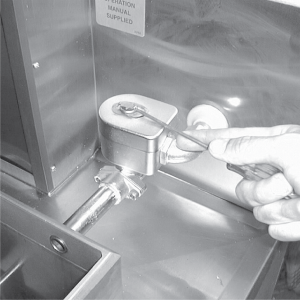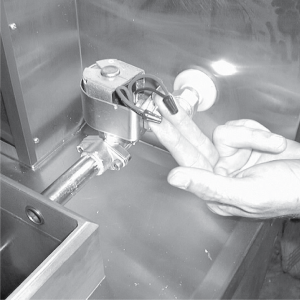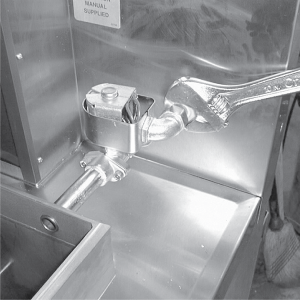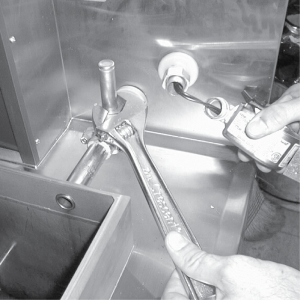This is an electro-mechanical device that causes pressure to be held in the vat. The solenoid valve closes at the beginning of the Cook Cycle and opens automatically at the end of the Cook Cycle. If this valve should become dirty, or the Tn seat nicked, pressure will not build up. The fryer uses a 120 volt, 60 Hz coil 208/240 volt 60 hertz coil (50 hertz internationally).
Coil Check Procedure
Remove the solenoid wires from the wire nuts which are found behind the control panel. Check across wires.
208/240 Volt, 60 Hertz 150 Ohms
208/240 Volt, 50 Hertz 230 Ohms
120 Volt, 60 Hertz 50 Ohms
Replacing

-
Remove the “tru-arc” retaining clip on top of coil housing.
-
Remove the cover.

-
If only the coil is to be replaced, disconnect two coil wires at wire nuts in the coil housing. Remove coil, insert new coil, and connect wires at wire nuts. Assemble in reverse order of disassembly.
-
If the core-disc assembly is sticking due to buildup of oil, breading, and food particles, proceed with the following steps:

-
Loosen the nut on the elbow from the back shroud.

-
Unscrew the solenoid bonnet assembly from the solenoid valve body.
-
Remove the solenoid bonnet assembly and bonnet gasket.
-
Remove the core-disc assembly, core spring retainer, and the core spring.
-
Wash all these parts in hot water.
If the seals need to be replaced, proceed to Step 6; otherwise, assemble in reverse order of disassembly. Assemble valve core and blade with smooth side and rounded edge of blade toward the disc spring guide.
-
-
Repair kit, Part No. 17120, is available if any of the seals must be replaced. If one seal is defective, replace all seals.
Solenoid body must be removed from the fryer for replacement of seals.
-
Remove back shroud and disconnect solenoid exhaust tube.
-
Remove the threaded nipple from the back of the solenoid.
-
Remove two adapter screws which attach the pipe adapter to the solenoid valve body.
-
Remove the disc spring, guide, and Teflon seat.
-
Clean the valve body.
-
Wet “O” ring around seat with water and insert O-ring assembly stide in valve through “IN” side of body. Use an eraser end of pencil and press in the seal until it snaps into place. Be careful not to mar or nick the seat.
The smallest nick can cause a pressure leak. Replace all O-ring seals that are in the parts kit and reassemble the valve.
-
If the complete valve is to be replaced, follow steps 1, 2, 3, 4, 6, 7, and 8 in this section.
-
Unscrew the adapter from the nipple coming from vat.
Related Content
Replacing the Drain Microswitch
Replacing the Drain Valve and Extension
Testing and Replacing the Power/Pump Switch
Replacing the Solenoid Below the Counter
PFG-690/691 & OFG-390/391 Pump Motor Relay Kit
PFG 690 and 691 Installing Filter Rinse Hose
Direct-Connect Retrofit Instructions (For use on fryers after SN: 391-LH016JC & 691-LH029JC)
Operating Instructions for PFG-691/OFG-391 Direct-Connect Oil System
PFG 691 Attaching the Rinse Hose Instructions
Troubleshooting the PFG 691 Oil Not Pumping
Troubleshooting the PFG 691 E-15 Drain Open Error Code
Reference
